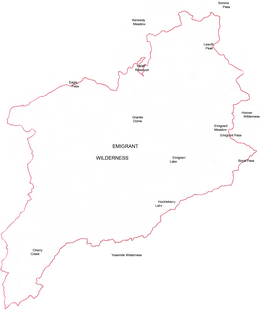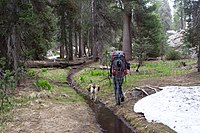| Emigrant Wilderness | |
|---|---|
| IUCN category Ib (wilderness area) | |
 Lake Lertora, Emigrant Wilderness Lake Lertora, Emigrant Wilderness | |
  | |
| Location | Tuolumne County, California, United States |
| Nearest city | Merced, CA |
| Coordinates | 38°11′07″N 119°45′53″W / 38.18528°N 119.76472°W / 38.18528; -119.76472 |
| Area | 112,277 acres (454.37 km) |
| Established | January 1, 1974 |
| Governing body | U.S. Forest Service |

The Emigrant Wilderness of Stanislaus National Forest is a formally designated wilderness area in the Sierra Nevada. It is bordered by Yosemite National Park on the south, the Toiyabe National Forest and the Hoover Wilderness on the east, and State Route 108 over Sonora Pass on the north. It is an elongated area that extends northeast about 25 miles (40 km) in length and up to 15 miles (24 km) in width. Watersheds drain to the Stanislaus and Tuolumne Rivers. The Emigrant Wilderness area, which is a glaciated landscape, is entirely within Tuolumne County, California and is approximately 140 miles (230 km) east of San Francisco, California and 50 miles (80 km) south of Lake Tahoe.
The northeastern third of the Wilderness is dominated by volcanic ridges and peaks; the remaining areas consist of many sparsely vegetated, granitic ridges interspersed with numerous lakes and meadows. Elevations range from below 5,000 feet (1,500 m) near Cherry Reservoir to 11,570 feet (3,527 m) at Leavitt Peak, but the elevation range of most of the popular areas is 7,500 to 9,000 feet (2,300 to 2,700 m). Precipitation averages 50 inches (1,300 mm) annually, 80% of it in the form of snow. Snowpacks typically linger into June, sometimes later following very wet winters. Summers are generally dry and mild, but afternoon thundershowers occur periodically and nighttime temperatures could dip below freezing anytime.
History
Various native peoples occupied this area for 10,000 years, spending the summer and early autumn hunting in the high country and trading with groups from the eastern side of the Sierra Nevada. The most recent groups were the Sierra Miwok of the western slope and Piute of the Great Basin.
Following the discovery of gold in 1848, large numbers of miners and settlers came to the Sierra and the native cultures quickly declined. In September–October 1852, the Clark-Skidmore party became the first emigrant group to travel the West Walker route over Emigrant Pass, continuing through a portion of the present-day Emigrant Wilderness. Several more emigrant parties were enticed by officials from Sonora to use this route in 1853, but it was a very difficult passage with many hardships and was soon abandoned. Relief Valley and Relief Reservoir were so named because of the assistance some emigrants received there from residents of the Sonora area.
In 1931, the United States Forest Service designated this area for primitive management as the Emigrant Basin Primitive Area. On January 4, 1975, the Emigrant Basin Primitive Area was designated as the Emigrant Wilderness.
Dam Controversy
Since 1975, 18 small dams in the Emigrant Wilderness have been the source of an unresolved political debate. The dams were constructed by anglers who tightly stacked nearby stones and boulders. Some support proposals to maintain the dams while others feel the dams should be allowed to decay in keeping with the Wilderness Act. A decision by the Stanislaus National Forest to compromise and leave some dams to naturally deteriorate while allowing maintenance of others was overturned in court in 2006, reigniting some of the controversy. The Forest Service chose not to appeal and the dams will gradually disappear.
Recreation
From Sonora Pass in the north, the Pacific Crest Trail follows a scenic route at the east edge of the Emigrant Wilderness along the high ridge past Leavitt Peak, turns further east from Kennedy Canyon to Bond Pass, and then heads south down Jack Main Canyon.
Many other trails criss-cross the Emigrant Wilderness, from Leavitt Meadow on the East side, Kennedy Meadow on the West side, and other trailheads. Highlights include cliffs in the Granite Dome area and lakes such as Emigrant Lake, Huckleberry Lake, and Lake Lertora.

References
- ^
 This article incorporates public domain material from Emigrant Wilderness. United States Department of Agriculture.
This article incorporates public domain material from Emigrant Wilderness. United States Department of Agriculture.
External links
 Media related to Emigrant Wilderness (category) at Wikimedia Commons
Media related to Emigrant Wilderness (category) at Wikimedia Commons- Wilderness.net
- TopoQuest map
| Sierra Nevada | ||||||||||||
|---|---|---|---|---|---|---|---|---|---|---|---|---|
| Mountains |
| |||||||||||
| Passes | ||||||||||||
| Rivers | ||||||||||||
| Lakes | ||||||||||||
| Protected areas |
| |||||||||||
| Communities | ||||||||||||
| Ski areas | ||||||||||||
| Trails | ||||||||||||
